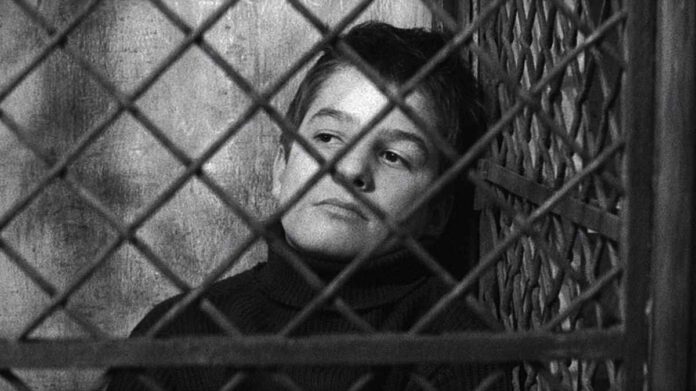Starting off in the closed confines of a classroom, shouted at by the teacher for causing mayhem, and ending on a beach with the waves sparkling towards him in what could be the most provocative moment in cinematic history, the wild, wild story of Antoine Doinel passes by with a swing. This change of landscape that happens over an hour and a half through the film converses not just with the troubled growing years of Doinel but also has an implication for what the film as a whole represents in the cultural milieu it was a part of. Autobiographical on the life of Truffaut and his traumatic early years, the film also makes place for his Cinema, a new kind that defied norms in many ways and was a major proponent of the French New Wave, the ideas of which were theorized by Truffaut, Bazin, and others from Cahiers du Cinéma. The film can be looked upon as a character study of Truffaut himself, where the early seeds are sown of the rebellion that he brought to the cinematic language by writing fierce criticism for many films in the magazine, unabashed in his approach and stunningly original in his ideas. And so, the shocking freeze-frame at the end of Doinel looking at the camera, his face drenched in anxiety for the life that he has run away from, and the poetic release of the entire sequence transitioning from the classroom to the liberating atmosphere that the tides represent, is reflective also of the ideas of Truffaut on Cinema and his life which was shaped along in the process.
The defiance that took shape in him as a result of multiple incidents in his childhood that made him grow apart from his parents found expression when he wrote about Cinema. A sense of disbelief in his peers, which, although built for different credible reasons, turned into disbelief of the entire status quo, driving from the isolated personal experience to the wider societal belief systems. To get into the head of Truffaut is to also understand that the base of his criticism of the traditional French Cinema lay somewhere in his personality; his blood racing with discomfort having seen a sort of exploitation of the medium keeps it chained to the dictates of the plot and elements of literature. It was not just coming from a blind urge to be defiant but was backed by a thorough contemplation of the arts. He mentions how he decided early on to watch three films a day and finish five books in three weeks. The revolt in his mind paved the way for his thoughts on Cinema to reach where they eventually did, and “The 400 Blows” is a milestone in that journey. It is a film important to Cinema, for what Truffaut merely articulated on paper prior to this, he brought to the screen, changing the way everyone looked at film. Starting with its title, which in French is an idiom, “Les quatre cents coups,” which means to live a wild life. It is reflective of the main character of the film, who wants to live without control and without limits at the same time, mirroring Truffaut, the filmmaker through this, who has lived that part of his life and made it what it is, or made him what he is. Reflective also of a changed perspective on Cinema, which, when married with a changed aesthetic, created a film that felt stunningly different and registered as a rebellion in the minds of people.
Truffaut’s ideas on Cinema, gleaming with ferocious clarity and newness, come from a love more for Cinema than the few people on whose hands it was only restricted to a certain point. “The 400 Blows” represents that important moment in the history of Cinema. Looking at it purely in terms of a story, barring its cultural context, it is the tender journey of a boy marching for more freedom in his young life. Doinel’s misadventures with his school friend and their growing bond amidst troubles both at school and home are a treat for the heart. Towards the end, when Doinel is sent to the juvenile center, and it’s a Parent’s Visit Day, he sees his friend standing outside, who has come to distribute newspapers. Thinking that he has come to meet him, Doinel is overjoyed, which doesn’t last long when he begins to leave. The two look at each other, saddened in their own hearts. It is a heartbreaking departure. Truffaut never romanticizes or leaves traces of nostalgia in a story that has bigger possibilities to evoke such feelings. But his camera is rough, just like his memories of a scarred childhood, which give the film an edgy atmosphere and build our empathy for the boy. It is Doinel’s journey from being forced to be a subdued individual to finally running away from it all, unable to breathe in a life full of control. Reflecting Doinel’s story is the journey of Truffaut himself and the formation of rebellion in his mind which then transformed onto the screen, becoming Cinema. Truffaut uses the medium to offer a glimpse into his past on the streets of Paris and, while doing so, reinvents cinema by bringing together certain theories looking at filmmakers around the world and how they molded the medium to the comforts of their own story. Consequently, “The 400 Blows” is a journey of Cinema from being looked upon just as an escape to the director becoming its ‘author,’ telling stories that are personal and using that sense to reach an evolved aesthetic. Truffaut brought to the Cinema not just a brick but an entire house.

